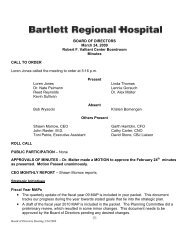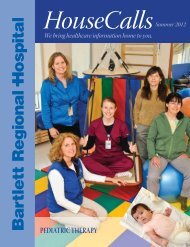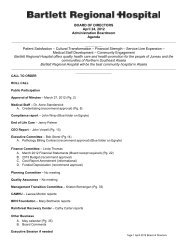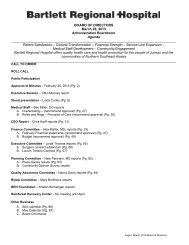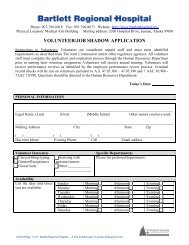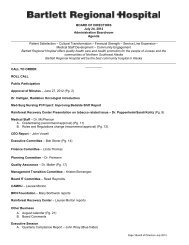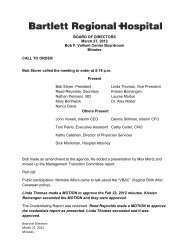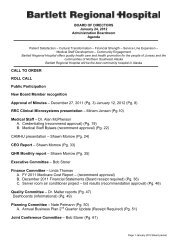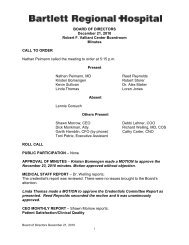Newsletter - Bartlett Regional Hospital
Newsletter - Bartlett Regional Hospital
Newsletter - Bartlett Regional Hospital
Create successful ePaper yourself
Turn your PDF publications into a flip-book with our unique Google optimized e-Paper software.
approved an operating budget— that we came under, by the way,” she says. Thompson<br />
praises Chief Nursing Officer Cathy Carter as being especially supportive and<br />
encouraging. “Overall, nurses throughout the hospital are very enthused about this.”<br />
“Previously, there wasn’t a formal structure,” says Hargrave. <strong>Bartlett</strong>’s Coordinating<br />
Council for Shared Governance held its first organizational meetings in mid-2010.<br />
There are currently two subcommittees: Clinical Practices and Professional Development.<br />
“Now we have the structure to make change. This is about nurses having<br />
control of their practice and having a robust structure that will improve communications,<br />
because it elevates the discussion to a professional level.”<br />
The front line staff: Sarah Sjostedt, RN, Billy Gardner, RN, Gail More head, RN, and Alicia Gillis, RN, discuss staff<br />
engagement in the shared governance process.<br />
The Origin of Shared Governance<br />
The concept of shared governance was first defined over 30 years ago as an<br />
effort to give nurses an equal voice with physicians within hospitals. Nationally,<br />
through the 1980s and 1990s, the concept broadened to one that embraced all levels of<br />
hospital management. A committee structure brings managers and staff to the same<br />
table where they address issues such as practice, management, quality, and education.<br />
Every department that utilizes the services of nurses is represented on <strong>Bartlett</strong>’s<br />
Shared Governance Council. “We are very early in the process,” says facilitator Sarah<br />
Hargrave. “Normally, it takes at least three years to have a robust structure.”<br />
“Shared governance to me is a means of pushing the nursing profession forward,”<br />
says Leslie Vianne, a <strong>Bartlett</strong> RN since 2004. “It will allow nursing across the country<br />
to self-regulate, to support more education that will get more nurses into the<br />
profession. It’s cool to be a part of it. I’ll be there supporting the effort, a brick in the<br />
foundation.”<br />
Coordinating Council for Shared Governance<br />
· Margie Fisher, RN (Co-Chair)- <strong>Bartlett</strong> Beginnings<br />
· Susan Thompson, RN (Co-Chair)- House Supervisor<br />
· Alicia Gillis, RN (Secretary)- Critical Care Unit<br />
· Brian Tennant, RN (Treasurer)- Emergency Department<br />
· Cece Brenner, RN- Medical/Surgical Unit<br />
· Cori Austin, RN- Same Day Care Unit<br />
· Hannah Mendelsohn, RN- Surgical Services<br />
· Sarah Sjostedt, RN- Medical/Surgical Unit<br />
· Amy Center, RN- House Supervisor<br />
· Robin Basque, RN- Mental Health Unit<br />
· Cathy Carter, RN- Chief Nursing Officer<br />
· William Gardner, RN- Medical/Surgical Unit Director<br />
· Gail Moorehead, RN- Staff Development<br />
· Sarah Hargrave, RN (Facilitator)-Quality Department<br />
Profile: Sandra Kohtz, continued from page 10<br />
with shame and moral condemnation.<br />
Kohtz would prefer that people look<br />
at Rainforest Recovery Center in the<br />
same way they would a doctor’s clinic.<br />
“Alcoholism and other addictions are<br />
medical conditions like diabetes,” she<br />
says, noting susceptibility to addiction<br />
is most often an inherited trait.<br />
Addiction, especially in older adults,<br />
can be very difficult, and almost impossible<br />
to turn around without help. “At a<br />
certain point, the addict will no longer<br />
be able to make rational judgments,”<br />
says Kohtz. “Almost always, they blame<br />
their problems on something other<br />
than their addictions.” Kohtz has yet<br />
to encounter someone who has come<br />
in for treatment without being compelled<br />
by their circumstances or by<br />
another person. “No one wants to go<br />
into treatment . Once you have found<br />
the impetus, it helps in providing them<br />
with the appropriate treatment.”<br />
When Kohtz began her career in 1977,<br />
treatment was largely designed on the<br />
Alcoholics Anonymous model. “At the<br />
time, if someone did not remain abstinent,<br />
they would be out of the program—they<br />
had not reached bottom,”<br />
she recalls. Kohtz explains that while<br />
the goal of RRC’s treatment approach<br />
is eventual abstinence, she is not one<br />
for absolutes. “Through treatment and<br />
other interventions, we are seeing people<br />
seeking help before they have lost<br />
everything.”<br />
Kohtz has a Master of Social Work<br />
Administration degree, is a Licensed<br />
Clinical Social Worker, and a Certified<br />
Alcohol and Drug Abuse Counselor.<br />
In 2003, she was named “Manager/<br />
Supervisor of the Year” for Nebraska<br />
Health and Human Services. She has<br />
also served on numerous boards of<br />
directors for substance abuse programs<br />
throughout her career.<br />
17 — Fall 2011



